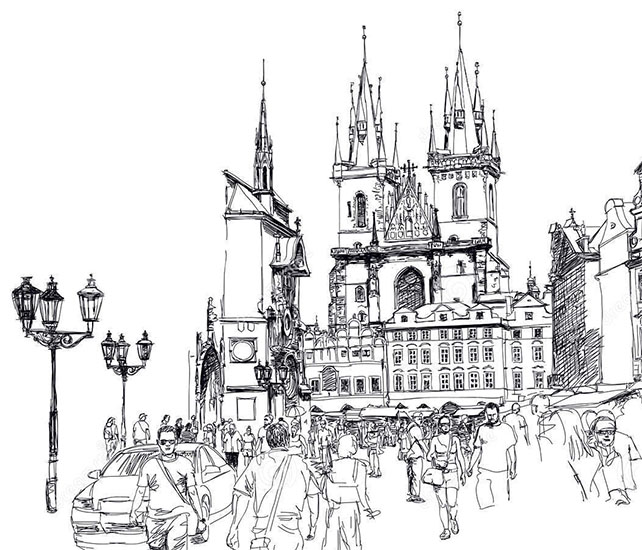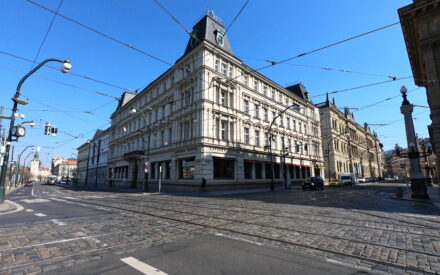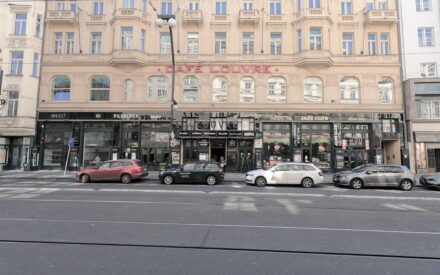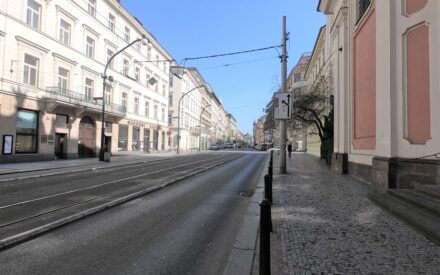Former garden house
In this house once lived the gardener who was in charge of the whole park. And at this juncture, we return to Kafka’s The Description of a Struggle (Beschreibung eines Kampfes), because this place is precisely where the fantastical narrative which is played out in the second part ends, and we come to the culmination of the entire text. Both the two main protagonists went up to this place very probably taking the route we took, and on the bench in front of this little house the narrator could finally relax. The first draft of this story ends thus:
Franz Kafka: The Description of a Struggle (Beschreibung eines Kampfes)
”The way it is,” said my acquaintance who had left the gathering with me and calmly walked next to me on one of the paths on the Petřín hill. “Stop at last for a while, so that I can sort it out in my head – You know, I need to deal with a certain thing. It is so exhausting – this chilly and bright night, but this unsettling wind even looks as if it is changing the position of those acacia trees.”
The shadow of the gardener’s cottage in the moonlight stretched out along the slightly arched path and was decorated with a dusting of snow. When I spotted a bench beside the door, I pointed to it with my outstretched hand, as I did not have enough courage and waited for a reproach, that is why I placed my Left hand across my chest.
He sat down in disgust, not looking at his smart clothes, and to my astonishment he pressed his elbows onto his thighs and placed his forehead into the bent tips of his fingers. […]
I was very cold and the sky was already beginning to look somewhat pale: “No wickedness will help hereabouts, no infidelity nor any journey to a far-away country. You will have to murder yourself,” said I and I even added a smile to that.
Two shrubs stood facing us on the other edge of the alley and beyond these bushes lay the city below. There were still a couple of lights shiningl […]
At that moment, and without more ado, my acquaintance pulled a knife from his pocket, opened it thoughtfully and then as if it were a game he stabbed it into his left arm above the elbow and did not pull it out. Blood gushed out immediately. His chubby face turned pale. I drew out the knife, slashed the sleeve of his overcoat and tuxedo, ripped the sleeve of his shirt. I then ran part of the way down and back up, so I could see if there was anyone around who might help me. All the tree branches were almost garishly visible and moving. Then I sucked at the deep gash a little. Suddenly I recalled the gardener’s cottage. I ran up the stairs to the elevated lawn on the left side of the cottage, hurriedly I tried the windows and doors, I rang the bell and banged on the door furiously, although I realised immediately the house was uninhabited. Then I looked at the wound, from where a thin trickle of blood flowed. I moistened his scarf in the snow and bandaged his arm awkwardly. […]
The lantern near the wall above glowed and projected the shadows of the tree trunks across the road and onto the white snow, while on the hillside, as if broken, rested the shadow of the assorted branches .
If we compare the scene just described with the surroundings of the “garden cottage“, we will realise how precisely Kafka has described the Petřín neighbourhood. As the path leading around the house goes downwards, the narrator really did have to run part of the way “down and up“ in order to calm down. On the narrower side of the cottage, along the downward slope, is a low extension of the building which still stands today. It descends on this side and simultaneously rises up at the back to form a straight ramp. The narrator ran down to this garden via the stairs, which were either never there, or else have been demolished by now. He was looking for help for his friend, supposing him to be injured in his hallucinatory imagination. It is understandable that no-one responded to his tapping on the window or on the door at the back of the cottage (situated near the upper path opposite). In winter there was no need to look after the park so no gardener lived in the house.
The rest of this area is also precisely the same: If we sit in front of the “garden cottage“, we can see before us bushes like those that Kafka describes in the text, because large trees cannot grow on the opposite bank. And right down below, in fact much closer than the alley leading to the observation tower at the top of the hill, lies the city with the river, Shooting Island (Střelecký ostrov), Franz’s Embankment (Františkovo nábřeží) and the Czech National Theatre.
According to the final paragraph of the quoted text we find ourselves on the Petřín slope. When Kafka then mentions the lighted lantern, which throws shadows of trees onto the hillside “near the wall above“, he cannot be thinking of anything other than the lone lamp still standing today on a section of the road leading directly around the Hunger Wall. Not only Kafka‘ characters went down this route for a nocturnal stroll, but also lovers of literature following in their footsteps.
This guided walk is a part of the “Democracy on the Brink. Historical lessons from the late 1930s” project supported by the Europe for Citizens programme of the European Union.
Další místa na téma "A literary walk through Kafka’s Prague on the trail of his story Description of a Struggle"



